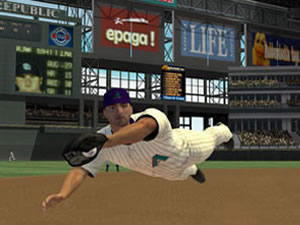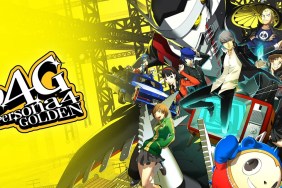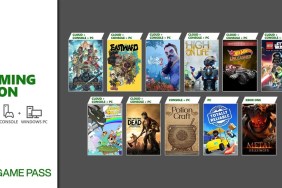Fielder’s choice.
When you have three baseball games all vying for your dollar, you want a clear winner. You want the critics to trumpet some name as the be-all end-all, while showering its competition with scorn and disdain. And if you can’t have that, then you at least want a clear-cut loser, a game you know you shouldn’t buy. The last thing you want to have to deal with is a trio of quality titles each besting the competition in certain areas while failing in others.
As a fan of baseball video games, this is what you face. It’s a win-win situation…or is that lose-lose?
We can try to make the decision easier for you, but the battle is so close it’s nearly impossible to call a winner. MVP 2005 has great gameplay, but is largely the same as it was last year. MLB 2K5, on the other hand, introduces a load of new ideas, but implements most of them poorly. MLB 2006 is the most hardcore baseball sim, but it is also extremely similar to MLB 2005 and uses some antiquated play mechanics.
MLB 2006‘s most interesting feature is its Career mode. Instead of stepping into the shoes of an owner or general manager, you’ll create a custom player and attempt to lead him to greatness. You’ll be able to tweak his attributes, gear, appearance, and even map your face onto his using the Eye Toy. While your players won’t look a whole lot like you when all is said and done, you can make some really crazy looking guys with this feature, which is more than the other games offer.
You’ll start out as a nobody and have to petition your manager for more playing time. Once you make your way into a game, you’ll want to strike out a few batters or knock one deep before you’re yanked out again. You’ll accrue bonus training time for this, which can be spent upgrading any of your numerous attributes, and use the day’s successes as leverage to ask for an increased role.
Once your player becomes legitimate other teams will come knocking, and you’ll get to haggle with contracts and offers from the player’s perspective. This gives MLB 2006‘s micro-managerial aspects a role-playing feel and, as it turns out, balancing a player is a lot more fun than balancing a budget. MLB 2006 also comes with an extremely dense, solid Franchise mode complete with a myriad of budgeting considerations and factors to tweak and toy with as you attempt to steer your team toward profitability.
Season mode fills the bases by putting you in control of all personnel decisions. You’ll hire scouts and coaches, put players on the trading block, and groom the talent in your AA and AAA teams for eventual roles on your big-league squad.
MLB 2006‘s modes are more comprehensive and satisfying than what MVP 2005 and MLB 2K5 offer, and its gameplay mechanics are solid, too. The pitching element uses the same release-point scheme found in MVP 2005, although MLB‘s meter is a bit more difficult to read. You simply select a pitch type and location, charge the meter for power and then press the button again for accuracy.
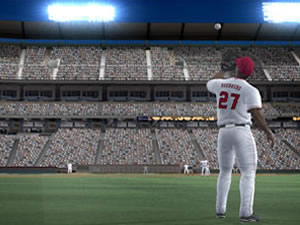 The only difference is that when you place any sort of breaking pitch, from a curveball to a change-up, the break isn’t taken into account.
The only difference is that when you place any sort of breaking pitch, from a curveball to a change-up, the break isn’t taken into account.
So if you’re throwing a curve and want it to wind up just underneath the bottom edge of the strike-zone, you’ll actually want to place it waist-high. After you throw the pitch, assuming it isn’t hit, you’ll see where you aimed it and where it wound up, giving you an idea of how your pitches are breaking so you can place them more accurately.
This is a better system than those used by other games because you can’t sit there and throw curveball after curveball right into the corner of the strike-zone. Instead, you have to anticipate the break and either have your pitch slice through the zone or risk hanging it.
So what initially seems like a pale-imitation of MVP‘s pitching model is actually a pale imitation with a really nice, hardcore twist.
The batting system is the same one MLB games have been using for years. Before the pitcher winds up you can choose a swing type (high or low) and then guess the pitch location and type. If you don’t make any guesses but time your swing well, you stand a good chance of getting a base hit. If you guess either the location or type correctly, the strike-zone will briefly flash to let you know you’ve made a wise choice. If you guess both correctly, the location of the ball will be telegraphed, making any contact good contact. The idea, we think, is that you’re supposed to take normal swings until you begin to notice a trend in the pitcher’s selection. Then, when you’re certain you know what’s coming next, you can key it in, lock on, and jack it out of the park.
This system isn’t new, although it is still pretty good. It’s especially effective against human opponents because they are more likely to get locked into basic patterns than the game’s seemingly random, nonsensical A.I. Seriously, the computer leads off with two change-ups, then throws a high curveball outside the strike-zone ” how are you ever going to see that coming? Even though this system is hardcore and has been popular for years, it doesn’t pack the punch it used to, especially thanks to EA’s brilliant Batter’s Eye feature.
MLB 2006‘s fielding game drops the ball, literally. Where other titles have fielding moves mapped to the R-stick, MLB 2006 simply has dive and jump mapped to the R1 and R2 buttons. The system works once you get the hang of it, but it’s still pretty unintuitive. Fielding fly balls is also hard to figure out. When a ball is hit in the air, a huge spinning baseball on the ground will indicate roughly where it is going to come down. As the ball gets nearer, the image spirals down to a point where the ball is actually going to land. If your fielder isn’t right on this point, he won’t catch the ball, so you constantly have to make adjustments.
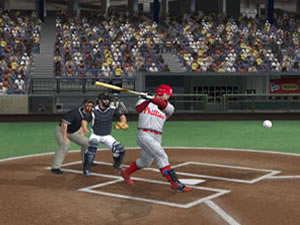 Adding difficulty to one of the more mundane elements of the game is a bit silly. No major league outfielder should ever run any risk of screwing up and dropping a routine fly ball, but it happens fairly often in MLB 2006.
Adding difficulty to one of the more mundane elements of the game is a bit silly. No major league outfielder should ever run any risk of screwing up and dropping a routine fly ball, but it happens fairly often in MLB 2006.
Although the offline content is solild, more daring PS2 owners can take MLB 2006 online. It has everything an online mode should, including rosters and exhibition games as well as a tournament system that can handle up to thirty players. Nice.
MLB 2006 is a study in uneven graphics: the textures and colors are always drab and unappealing, while the animations are always smooth and crisp. The ball zips off the bat when struck, players transition seamlessly from running to diving, and throws from base to base are crisp and sharp, especially during double-play attempts. If only the general look was as good as the movement.
We were certain when we played it that no game could rival MVP 2005‘s awful music and repetitive commentary, but lo and behold, MLB 2006 actually surpasses MVP in both of these categories with an angsty thrash soundtrack and some of the most repetitive comments ever. Since MLB 2006 is exclusively for the Sony PS2, you can forget about replacing the game’s heinous soundtrack with one of your own, so we suggest simply turning up the radio.
The competition is tough, but MLB 2006 is another solid, hardcore baseball game from 989. It hits hard thanks to a robust single-player package, decent online content, and a smart pitching scheme, while a dated batting system, bad fielding model and relatively high price tag ($40 versus $20 for MLB 2K5 and $30 for MVP 2005) prevent it from entering a league of its own.
-
Lots of content
-
Decent pitching system
-
Good online features
-
Dated play mechanics
-
Doesn't look very good
